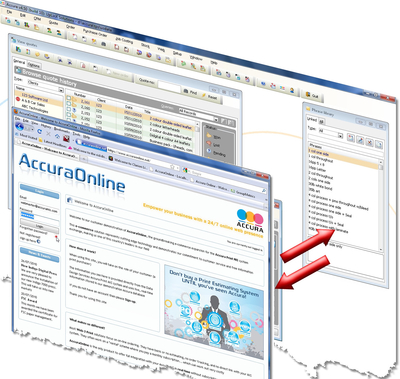Some MIS systems have developed towards digital print from more traditional print operations; others have been created specifically for the digital print market. And then there is Enterprise Resource Planning (ERP)…Digital Printer spoke to several vendors about how their MIS/ERP products have been and are developing for digital.
Trevor Cocks – Accura
These days, many printers have some digital, some litho, some wide format, and over 25 years we’ve adapted our product to cope with that. We’ve written in features like click charge support, and unit price matrices, which give a better margin than hourly rates.
Digital companies are a lot more go-ahead than traditional companies; they’re looking at cross media and web store fronts, and we’ve spent a lot of time investing in our own web to print, Accura Online, that integrates with the MIS.
We believe we have a pretty unique offering there. Others write links with other MIS systems but those links tend to be pretty tenuous and uni-directional. Ours is bi-directional, real time, point and click. We have come at it from the opposite direction to most – we’ve got an MIS with all this information, we’re opening that up to the client base so they can access a multitude of information – quote history, order history, invoicing, delivery notes etc.

Every kind of job will be routed through the MIS before it goes anywhere and will pick up the data that it needs to have a job bag that means something. Our Estimate Template Library allows customers to store shell estimates with all the workings embedded and reuse them over and again. In a print company with skilled estimators and customer service reps without skills, the CSRs can therefore use the templates, and so spread the workload.
Litho print was marked up on cost, but digital will work more on a published rate card – the website might say 500 of this product is this much. In Accura, you’re working from a price list but the system still shows you the cost base, so you can see the mark up. That’s key. If you’re just working from a price list, you don’t know if you’re making a profit.
John Clark, Almabyte
With digital it’s all about fast turnaround; in that respect our new system Print & Plan can set up product specific templates; you can produce a quick quote and turn that into a job. You can integrate to SAP but it comes with an entry level accounting and CRM system for SMEs with lots of management tools.
Print & Plan does estimates very accurately, but you still need to have the information. The work has to be making you money. We’re trying to improve processes so that customers can get quotes out fast, and get the job started faster.
Another thing very relevant to digital is to integrate to a web to print system, so that customers can order and pay for jobs online, and it goes straight into the MIS to generate theorder. We’re trying to cut down on the time it takes from payment to delivering the job. We are currently integrated with one system called B2C Print, although it is possible to make links to other systems.
It’s all about process; getting information flowing within the company. The idea is to have a workflow element so that each department knows what’s coming through to them, and they can prepare the right materials and resources for it. The next step with digital is generating job information whichever way it has come in. It should not matter whether it has come from a standard quote or the web to print site.
Emerson Welch, Clarity 
We do cover all formats of print but our major focus is on digital print and wide format jobs. We can track the job right through from lead generation, giving a detailed, accurate estimate and the final quote through to customer. It is based on a total breakdown of all the factors for that job. By the end you will be able to clearly see how much it will cost, how long it will take, what the machine optimisation will be, how much ink will be used, and so on.
It all starts with a good strong quote, and we say you can quote for anything with Clarity because of the quoting logic behind it. It has lots of little short cuts for printers to be able to quickly get together a quote and win business against other companies that are still putting their finger in the air. It works through to production too.
You can see from the production schedule that there’s a slot for the customer, you know how long it will take, how much it will cost, and if you’ve got the stock in already. We have spent a lot of time developing software to optimise roll stock. There has been this off-cut scenario where customers were chucking away the end bits of a roll of media, but we have developed this so they can save on material waste and keep less stock in hand.
The software allows customers to intelligently nest jobs onto a roll, and if there’s a remainder unused on that roll, you can create a new stock ID, re-allocate it back into stock, and the next job for that material can be allocated to that. That’s massive for digital printers that print onto rolls.
Steve Richardson, Optimus

We launched a new interface in 2010 called Optimus dash, which was fundamentally different to how MIS operated. Before, when the industry ran in straight lines, MIS companies would come up with a bit of logic and if your world view matched the MIS logic that was fine. We came up with a more process driven approach that would drive the back end elements of Optimus the way you need it to seamlessly. It has changed our business beyond recognition.
What you’ve got now is a high degree of configurability. We could always direct the workflow with custom coding but that was an expensive and lengthy process. It’s much easier now. With the right skill set most clients can build their own systems and templates. It’s now about configuration, rather than writing code.
We’ve tried to take a holistic approach to everything that the MIS touches on. We’ve gone into print environments in the last few years and observed and recorded the aspects that don’t work. Everything has a start, middle and end in terms of process, so if you strip it back down to the functions that you have to do in a certain way, you can start moulding the environment. We’ve created building blocks that you can use to mould the level of complexity.
With digital, speed of process is absolutely critical. If you’re too busy clicking through screens to get the job set up, you have just lost your margin. We provide very high levels of automation that can be designed and managed by the client, giving them more control.
And we are very consultative. We take time to study and record what the issues are and map the processes, and it is far more compelling. We are drilling down into new territory with MIS.
Paul Deane, Shuttleworth

As the volume of transactions has gone up, the value has gone down and the lead times have shortened, we have had to automate processes that were not previously automated for the demands of short run work. We have removed a lot of the touch points for the printer and taken the admin cost out.
Now, when a job comes in, you can drag and drop the Purchase Order into the system, which creates an order, and at that point you can enter multiple orders from the customer’s spread sheet and batch print all the works tickets, if you’re not sending them electronically; we can put the delivery note and box labels as part of the same document. Then it can automatically process and email all of the invoices.
We also have quite a significant development that is just about to be released on the scheduling side. In short run and digital, companies are trying to process a huge amount of work in a short period of time, and they need visibility of capacity. We have automated our planning system so that it automatically sorts and schedules jobs. It gives you a capacity view and highlights if there is a problem. You can do things like look at how much processing time or how much finishing there is on the job, work out the difference between that and the delivery date, and compare it with other jobs.
All MIS developers are looking at better ways to automate the degree of interaction with the customer’s customers at the front end.
That’s very challenging because many don’t have structure in their data. For those companies doing a lot of management of print and putting work out, we can certainly look at automating their supply chain. Every issue we are talking about for digital printers applies to most commercial print environments; it’s just more dramatic within the digital print environment.
Lee Ward – Tharstern

In our eyes, the estimate is king. A good estimate flies the whole production workflow, so it has to support all the different ways of producing jobs. We launched Estimate Pro, our new estimating module, about 12 months ago. What that does is take the spec of a job and calculate all the various ways of producing it. The user does not need to know how it will print.
Estimate Pro is more comprehensive than Classic, our legacy system. Pro takes the intelligence of the end user out of estimating. You don’t need production knowledge, you just need to know what the customer wants and the system will come back with the best method.
There’s also the scheduling area and shop floor data capture, which are important in a very fast moving environment. Digital organisations need a very quick way of capturing job data, and we have a system called FastTrack, which uses bar coding for shop floor data capture. That’s the best way to capture costs in the job.
With scheduling we have our ‘airport departure board’, which sort jobs for priority; it’s a dashboard that puts the jobs in logical order. The idea was to try and help digital companies with more efficient scheduling, but it has evolved into other sectors, including pure litho.
When people first buy an MIS they see all the benefits of implementing it, but when you revisit a year later often they have slipped into bad habits. They lose the internal management of their system, the reasons why they implemented MIS. Also, customers find a new angle to go down in their business but they don’t think the MIS can cater for it, so they manage that outside the MIS. From our point of view, there’s usually a way to cater for something diverse in the system.
Geoff Stephens, Time Harvest

We are focused on the digital market only, which for us can be everything from business cards to building wraps. By and large digital printing companies do have smaller job values but many, many more of them. In digital, if you have not got a quote back within the hour you are dead in the water. The essence of being able to do that is simplicity.
It’s not just getting the quotes out quickly though; it’s also being able to manage complex jobs with many parts on one Day Board.
Each part is critical to the whole project being delivered on time. Most users have this board on a big cinema display so everyone can see progress. Most importantly, at the end of the process, you have a list of completed jobs, and the golden rule is to invoice as soon as completed.
If a digital company is not using an MIS, typically you find that they are entering information three times: in the sales process; when a quote becomes a job; and because there is often almost no linkage between production and accounts, at invoice stage. That’s a killer in the digital world.
Utilisation of the asset – the press – is not as important in the digital market as it is in traditional litho, but toner is still a relatively high part of the cost of a job. Selecting the right toner coverage is important and we make that easy with PrintCalc, which calculates coverage from the PDF. What’s critical is setting the average toner consumption and knowing the cost of the toner.
The challenge for users with web to print streams alongside jobbing work or custom digital printing is how to merge them onto one Day Board. There is no neat way of integrating them at the moment, but we think that process will become simpler as data formats merge. n
MIS & ERP
Danny Morris – EFI

In the past, what we saw with a lot of commercial printers was that they knew they needed to embrace digital technology, but no-one really managed the business of that.
Digital is driving more automation, and therefore you need to create an environment that’s automated but that can also handle the long run work that’s still there.
We have had a policy of acquiring MIS systems, absorbing the technology, and giving people the comfort that they can grow their businesses with automation in the future.
EFI Pace is designed to accommodate digital print and traditional print as well as wide format. We have interfaces into our own web to print and extensive APIs for other systems. MIS needs a complete fit with web to print.
You need to be able to accommodate online business and feed back into MIS. Automation is king. Print Flow is a dynamic scheduling module; it will look at your plant as a whole, move jobs, control stock etc., it makes things possible. We still see manual processes in scheduling jobs across the plant.
History has shown that, once they have a close relationship with an MIS provider, most printers stay with them for a long time. It would be a bigger decision to invest in a new MIS than a new piece of kit. And that’s the right mentality: the emerging entrepreneurs of commercial print need to focus less on the specifications of the technology, and more on how their businesses are run.
For us, MIS and ERP are interchangeable words, and it is all about scale and size. What you have to bear in mind with ERP it is for multiple sites and beyond that, international – so you’re talking about visibility of the plant across borders, multiple tax and VAT systems, and multiple currencies, and bringing that together in your financials in one currency.
Gavin Tye, Crimsonwing ERP is an old concept, but it’s new to the printing industry. While MIS was always modular, ERP is a singular product, replacing all the different software in different locations into one package. It’s based on a financial solution and builds up from that, so it is very strong in reporting. Everyone is looking at the same pool of data, and when you make a change it feeds back to the warehouse instantly.
It’s certainly not the case that ERP is only for big companies. We have got clients with just two or three users. The perception that it was for the larger arena has been addressed by Microsoft with its Microsoft Dynamics NAV, and with the cloud it’s not such a concern if smaller companies don’t have the infrastructure to support ERP. With the tools in the smaller package, the roll out is very quick, and you get a comprehensive view across the whole business in one window, with a single database using live data.
Historically, ERP has been very configurable and you had to find out a lot about the company before implementing it, but with this system it is more out of the box. We build a couple of financial templates to start with and roll that out.
Some printers are being run by finance rather than production; they are taking greater interest in the profitability of each job than ever before; they need data to do that, and ERP helps with that. Job costing and financial reporting is far more important to printers now than just estimating. We’re seeing printers turn jobs away that are non-profitable.
You can now make these decisions based on knowledge rather than guesswork.





